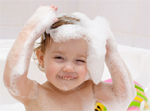Many personal care products contain hazardous substances in concentrations that would require labeling, but they are excluded from the regulation of classification and labeling of chemicals (Regulation Classification, Labeling and Packaging, CLP). The Cosmetics Directive prescribes instead that the ingredients must be listed on the packaging by amount with names as given by the International Nomenclature of Cosmetic Ingredients list (inventory and a common nomenclature of ingredients employed in cosmetic products, INCI).
Dedicated consumers can find out which substances are hazardous, by picking out the CAS number of a substance from the INCI list, and searching the Classification Labeling Inventory (C+L Inventory) database to see if and how dangerous the substance is.
However, the health risk of personal care products may be increased by combination effects. Also, degradation or reaction products may be more dangerous than the starting materials. For example, in the oxidation of the fragrance limonene, e.g., hydroperoxides are formed and cocamide diethanolamine and triethanolamine in eye makeup can form carcinogenic nitrosamines.
Only few consumers realize that natural substances can be hazardous substances, too.
If personal care products were labeled with hazard symbols like other products, Ursula Klaschka, University of Ulm, Germany, thinks mindful consumers could handle these products more suitably. If consumers then favor products with lower hazard warnings, for manufacturers, it would be worthwhile to develop a range of products that are not classified as dangerous and yet fulfill their functions satisfactorily.
- Warum sind Shampoos frei von Warnhinweisen?,
Ursula Klaschka,
Nachr. Chem. 2013, 5, 530–532.
DOI: 10.1002/nadc.201390163
Also of interest:
- Classification Labelling Inventory (C+L Inventory) database,
European Chemicals Agency (ECHA), Helsinki, Finland
- Shampoo Science,
ChemViews magazine 2013, January.
DOI: 10.1002/chemv.201200149
The composition of a typical shampoo and how it works

